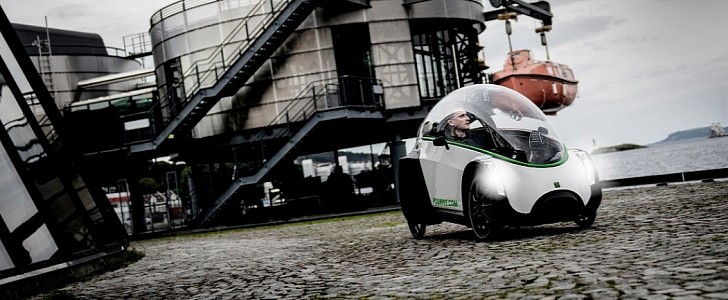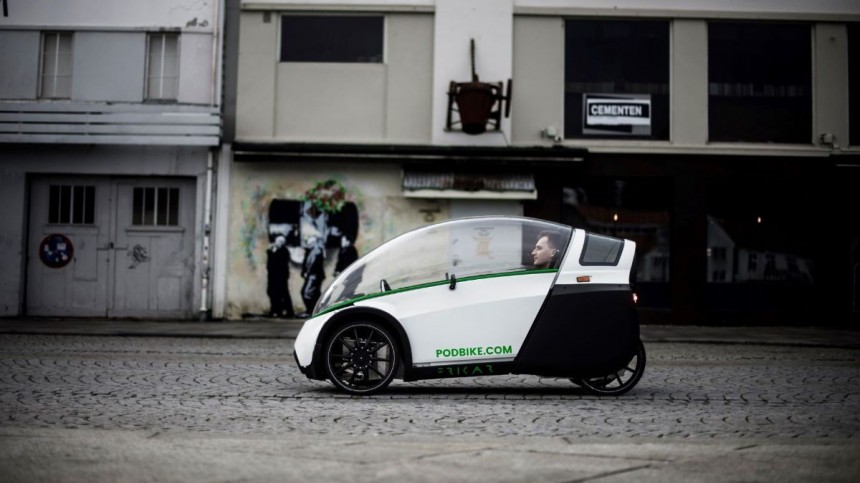As people are starting to adopt more eco-friendly ways of transportation, we're seeing an increasing number of EVs filling up the cities. But there's one machine that claims to bridge the gap between a car and a bike, all while offering a sustainable commuting alternative. Meet the Podbike Frikar, a four-wheeled velomobile that can reach a top speed of 60 kph (37 mph) downhill.
A velomobile can be defined as a recumbent tricycle enclosed in an aerodynamic shell that provides protection. Usually, the velomobiles are human-powered, similar to a bike, but recently some of them have been converted to provide electric assist.
The Pobike Frikar is an electric velomobile that runs on four wheels, and it's the creation of a Norwegian startup that believes personal mobility "should be fun, inspiring and good for our planet." Founded in 2016, the company wanted to make something that would provide the comfort of a car and deliver the performance of a modern e-bike, all while contributing to climate change.
And it did. The first prototype of the Podbike was presented four years ago. The major goal in designing the Podbike Frikar for the team was to obtain a better volomobile than what was on the market by adding more function-focused features.
Since then, the vehicle has been thoroughly tested to make sure that everything worked accordingly. And now, several years later, the Podbike is finally ready to hit the streets.
The Frikar measures 90.5 inches (230 cm) in length and 33 inches (84 cm) wide, offering great maneuverability. The company says that Podbike is about 2 inches higher than a Lamborghini Miura, so the rider will feel like riding a car when stepping into the Frikar.
The velomobile actually uses the best of both worlds. In Europe, it's classified as a cycle, so it can be used on bike lanes, and there's no need for a license to get behind the wheel. The shell offers an additional layer of protection that keeps the rider safe in case of collision.
To get around, Podbike uses three motors, not one as most e-bikes do. Using the vehicle's pedals, the rider will generate power that will be transferred to two motors located in each rear wheel. Both motors also serve as regenerative brakes. In steep terrain, regeneration can boost the vehicle's range by up to 40 percent.
For electric assist, it uses one 250W motor that delivers a limited top speed of 25 kph (16 mph) and one 250W motor for series hybrid propulsion. However, by continuing to pedal, the speed can be increased, depending on different factors such as inclination or rolling resistance. Downhill, the Podbike can actually reach a good 60 kph (37 mph).
The range can vary as it depends on the pedaling power. However, the company says that the volomobile comes with an 877 Wh battery that should be enough for an estimated 80 km (50 miles). The range can be extended by adding a power module that can carry up to two battery packs.
Inside, the Frikar has one seat and plenty of room behind it where the rider can put their luggage. For those who want to bring their little one with them, that space can be occupied by a child seat. Or, if they plan to explore the great outdoors, a bicycle trailer can be mounted instead.
The Frikar will include lights at the front and back, and turn signals on each side. The body will also be outfitted with reflectors to make it visible at night in traffic. During the hot summer days, the canopy can be removed.
The company plans to equip the Podbike in the future with semi-autonomous features, allowing it to park and charge itself.
Production for the new volomobile has already started this fall. Pricing starts from € 4995, which is around $5,638 without taxes. The Podbike Frikar is currently available in every European country. Those from outside Europe will be able to order the vehicle on demand and according to their country's regulations. Customer deliveries are expected to begin in 2023.
The Pobike Frikar is an electric velomobile that runs on four wheels, and it's the creation of a Norwegian startup that believes personal mobility "should be fun, inspiring and good for our planet." Founded in 2016, the company wanted to make something that would provide the comfort of a car and deliver the performance of a modern e-bike, all while contributing to climate change.
And it did. The first prototype of the Podbike was presented four years ago. The major goal in designing the Podbike Frikar for the team was to obtain a better volomobile than what was on the market by adding more function-focused features.
Since then, the vehicle has been thoroughly tested to make sure that everything worked accordingly. And now, several years later, the Podbike is finally ready to hit the streets.
The velomobile actually uses the best of both worlds. In Europe, it's classified as a cycle, so it can be used on bike lanes, and there's no need for a license to get behind the wheel. The shell offers an additional layer of protection that keeps the rider safe in case of collision.
To get around, Podbike uses three motors, not one as most e-bikes do. Using the vehicle's pedals, the rider will generate power that will be transferred to two motors located in each rear wheel. Both motors also serve as regenerative brakes. In steep terrain, regeneration can boost the vehicle's range by up to 40 percent.
For electric assist, it uses one 250W motor that delivers a limited top speed of 25 kph (16 mph) and one 250W motor for series hybrid propulsion. However, by continuing to pedal, the speed can be increased, depending on different factors such as inclination or rolling resistance. Downhill, the Podbike can actually reach a good 60 kph (37 mph).
Inside, the Frikar has one seat and plenty of room behind it where the rider can put their luggage. For those who want to bring their little one with them, that space can be occupied by a child seat. Or, if they plan to explore the great outdoors, a bicycle trailer can be mounted instead.
The Frikar will include lights at the front and back, and turn signals on each side. The body will also be outfitted with reflectors to make it visible at night in traffic. During the hot summer days, the canopy can be removed.
The company plans to equip the Podbike in the future with semi-autonomous features, allowing it to park and charge itself.
Production for the new volomobile has already started this fall. Pricing starts from € 4995, which is around $5,638 without taxes. The Podbike Frikar is currently available in every European country. Those from outside Europe will be able to order the vehicle on demand and according to their country's regulations. Customer deliveries are expected to begin in 2023.















